French Vocalion
The CLPGS Reference Series booklet and CD is now out (see below). It references John Humbley's work on French Vocalion issues, but gives this page in error. If you came here for John's article, click here. Please note, the English translation starts half-way down.
AN ORCHESTRELLE RECORD.
Some time in the early 1970s I saw in a sales list of the veteran dealer J H Crawley a test pressing by the Russian tenor Vladimir Rosing. He identified it as unpublished, because, in an exuberance of his characteristic descriptive powers, "you would need a microscope to hear anything from this". It was not expensive, so on a hunch I added it to my order, and in due course one of his wood and hardboard packing crates arrived.
Looking closely at the record, I immediately recognised the problem. Had J H Crawley actually used a microsope on the grooves, he would have seen why he couldn't hear it. They were were narrow like a normal 78, but unlike a normal 78 they were vertically modulated.
Thus begins a search which has occupied me on and off for the last forty years.
In the early 70s I wouldn't have known of Marathon records, nor of the first US Aeolian Vocalions. Over the years I saw examples of these and recognised the distinctive grooves, but I couldn't tie my test pressing down to either label. In the event, all three are interconnected in a way that I didn't suspect.
I claim no credit for finding the answer. The essential clues were published quite a few years ago, but in piecing the threads together I uncovered a few (to me) interesting details, and as always, a fresh set of questions.
THE RECORD
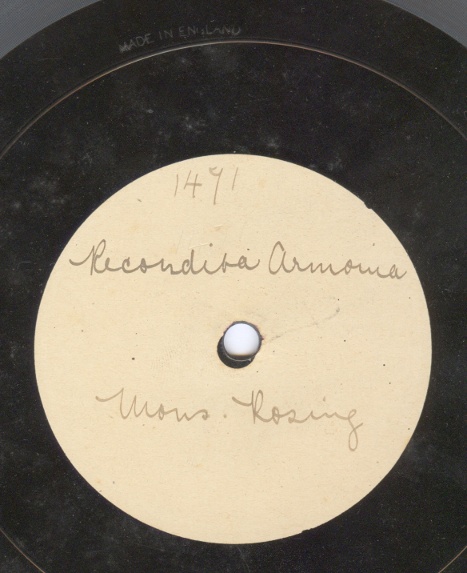
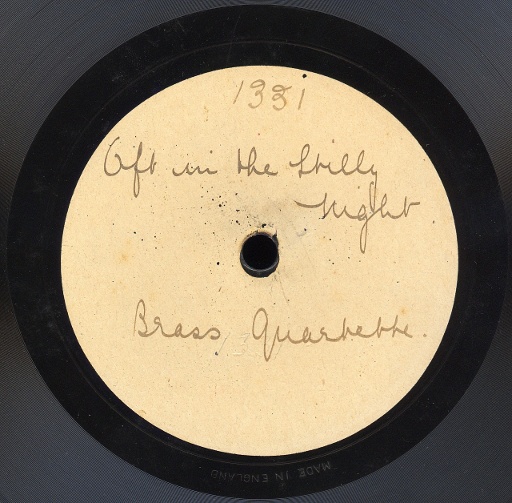
The record is a ten inch white label pressing with title, artist and matrix number written on each side's label. The matrix number is also visible under the label, as written in the wax. There is MADE IN ENGLAND in a curve "stamped" in the unrecorded space outside the label. This stamp is also seen on all UK Aeolian Vocalions and on other records pressed at their factory in Hayes. In those the letters are sunk below the surface, but in this test they are raised. A very similar stamp was used by the Disc Record Company Ltd from about 1907, but measurement shows that it is not the same.
The record has raised guard rings outside the label and the at the outside edge, in the typical pre World War I style. It is a little larger than the nominal 25cm/10 inch diameter as is usual for records with guard rings.
written in ink on label: 1471 Recondita Armonia / Mons.Rosing. 1471 written in wax visible under label. Other side: 1331 Oft In The Stilly Night / Brass Quartette. 1331 written in wax visible under label.
The Rosing side is accompanied by an orchestra which is missing its lower instruments.
It is a vertical-cut record, but unlike cylinders and Pathe discs it uses a narrow V groove played with a normal steel needle, not a large sapphire. The narrow grooves and the lack of lateral movement allow for a finer groove spacing than with normal lateral cut records and they can play for longer than a normal record of the same diameter. This technique, often known as the "Packman cut" was developed in the UK by the British engineer Percy Packman and was first used for the UK record label Marathon, made by the National Gramophone Co. from 1912 until 1915 when the owning company was liquidated. We next come across it on US Aeolian Vocalion records, made by the US Aeolian company and issued between 1918 and 1920.
IDENTIFICATION
It seemed clear that the record had to be either a Marathon or a US Vocalion, in either case unpublished. Physically it looks much more like a Marathon and the matrix numbers could be a continuation of the Marathon series, which seem to start from 1 and go up to the 900s on published records. The high matrix numbers 1331 and 1471 of course require explanation. This would suggest that Marathon in its last days recorded several hundred sides which were not issued at the time the company went into liquidation.
Marathon?
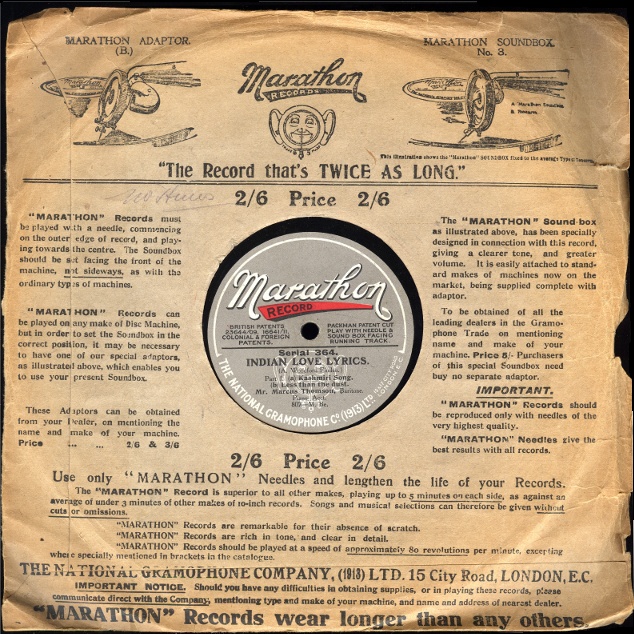
A Marathon record
The style of the matrix number written in the wax argues against a Marathon identification. The handwriting is different from any Marathons and in particular is missing the hot-cross-bun symbol ⊕ that Marathon matrix numbers have, no doubt to indicate the important difference of the vertical cut. Any numbers or letters punch-embossed in the metalwork can of course be disregarded, as a test pressing is likely not to have these.
Marathon were commercially ambitious, as any company launching a new incompatible format would have to be, but they were not artistically ambitious, sticking to popular material by standard recording artists. An operatic title by a foreign artist would have looked out of place in the list of published Marathons.
The first important clue comes from Frank Andrews [TMR 72, April 1987], explaining the adoption of this technology in the US. He reports that in August 1915 all of Marathon's assets were sold at auction as one lot, including about 1000 "masters" and worldwide patents for the Packman cut. Who was the successful bidder is not known but it must have come into the possession of the Orchestrelle Company, which was marketing gramophones and more notably the Aeolian range of mechanical musical instruments, whose name it shortly afterwards took to become the (UK) Aeolian Co. Ltd.
The "about 1000 masters" I think proves that the test record cannot be a Marathon, as it agrees fairly well with the number of issued sides and the highest numbers seen on issued records. There was no large stock of recorded sides, made towards the end of the company's existence, but unpublished at the time of its liquidation.
We can reasonably suppose that Orchestrelle were acting as agents for the US company in acquiring the Marathon assets. It is well known that in the US an agreement between the major record manufacturers to pool several vital patents made it impossible for new record companies to enter the market using conventional recording techniques, and a number of unusual formats were used to get around this restriction. The US Aeolian company was one of these new entrants, and this explains why the the first US Aeolian Vocalions were not laterals.
US Aeolian's first records were issued in 1918. A very few British recordings were issued, and all can be traced to Marathon sides previously published in the UK.
The need for non-standard playback equipment must have been a significant barrier to sales, and when by around 1920 the relevant patents had expired, all these companies, including Aeolian, dropped the formats like hot coals in favour of standard lateral cut recordings. This situation did not apply in the UK and few non-standard formats were tried here. Of those that were, fewer still succeeded for long.
US Aeolian Vocalion?
Disregarding for the moment the problem of the record's MADE IN ENGLAND stamp, the next obvious source of the record must be the other place where Packman cut recordings were made, the US Aeolian company in New York. This theory would explain the high matrix numbers, as the company had recorded nearly 3000 numbered sides before abandoning the vertical cut format. Again however, the physical details don't match. US Aeolian matrix numbers appear in a characteristic handwriting and are written below the centre hole (though they tend to appear rotated to its left in pressings). Most obviously, no Aeolians have guard rings.
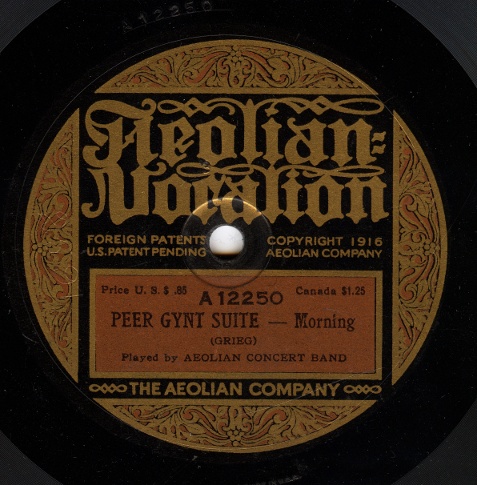
A US Aeolian vertical-cut record
To digress, guard rings are common on records sold in Britain up to the First World War, but must rapidly have started to look old-fashioned by the end of the war. Many US labels had never used them, HMV discs lost their thick edge around 1914 and Columbia followed suit in 1917. The last (to me) known appearance of guard rings is on Soviet Russian discs recorded as late as 1926, which can be explained by nearly a decade of isolation from the West.
Ryan Barna, who compiled the listing of vertical cut US Aeolian Vocalions, dates matrix 1471 to around December 1918. Neither of my matrix numbers has been traced to a known US Aeolian.
But the clincher is the fact that Vladimir Rosing was in Britain in 1918 and never visited the US until November 1921. Matrix number dating aside, by then the Packman cut was as dead as the dodo.
Orchestrelle?
At this point, we have eliminated the impossible, and now have to see if, as Sherlock Holmes said, "whatever remains, no matter how improbable, must be the truth". For many years I was in the position that I knew that the recording was not made by Marathon, nor in America, and, from the MADE IN ENGLAND stamp, was apparently pressed by the UK Aeolian Company's pressing plant. But neither I nor anyone else I spoke to was willing to believe where this led.
Again Frank had found the missing piece [HD 117, Nov 1980]. In February 1917 the Orchestrelle Company (soon after renamed Aeolian) opened a recording laboratory in Chiswell Street, London, where Percy Packman, C.R. "Johnny" Johnstone and Percy Quick started to record using the Packman cut. The intention was to send the waxes to the US company for "processing into records". Johnstone cannot in fact have been present, having arrived in New York on the 7th February, probably in connection with the US recording programme.
With this fact, other things click into place. The comparatively highbrow music and performer are explained. Rosing had a long association with Orchestrelle, having first appeared at their Aeolian Hall concert hall in New Bond Street in 1914 and regularly from 1916. He was also a fairly experienced recording artist, having first recorded for the Gramophone Co. in 1912 in St Petersburg and from 1913 to 1916 in London. His records were amongst the first issues on the UK Aeolian Vocalion label in December 1920.
From this it's unclear whether this laboratory was simply a foreign outpost of the US company's operations, or if there was any intention to import the finished product to Britain or even to ship stampers back here for local pressing. In the event, in the same month of February 1917, Germany resumed a policy of U-boat attacks on neutral merchant shipping, which led to the US entering the war in April, and incidentally no doubt affected plans to process waxes in the US.
Here a note is needed about company and brand names. The names Aeolian, Vocalion and Orchestrelle were the names of companies in the US from the 1880s that made mechanical musical instruments, typically player pianos and organs of high quality. The complexity of their naming evidences a long history of joint- and part-ownership and acquistions, perhaps encouraged by the fashion for grand, multi-word product names. Both Aeolian and Orchestrelle existed as company names at different times in the US and in the UK. The Aeolian Co. Ltd was registered in the UK in 1903, the Orchestrelle Company in 1912, which may at the same time have taken over the Aeolian company. Gramophones were sold by the Orchestrelle Co., which gradually changed its name to Aeolian from around 1918. Aeolian Vocalion was the brand name for a range of products and was used as the name for the first published records in both countries. Whatever was the correct company name at any time and place, in practice over this period there were two closely related companies, one in the US and one in the UK, each preparing to produce records, and eventually successfully marketing them. I aim here for clarity rather than legal precision.
Dating the record
The remaining possibility supported by any evidence is that this is a recording made for the Orchestrelle or Aeolian Co. But the date of recording and pressing is not clear. The obvious supposition is that the sides were recorded in the Chiswell Street recording laboratory soon after February 1917, and that the laboratory did not last for very long. Against this hypothesis are the high matrix numbers, and Rosing's earliest published Vocalion recording (possibly the earliest-recorded Vocalion side to be published) being of the same title. Lastly, the MADE IN ENGLAND stamp seems to identify the pressing plant as the Aeolian Company's one at Hayes, for which building started in April 1919. We can at least set out limits on the recording date; February 1917 at the earliest and mid-1919 at the latest, the date now given for the first lateral recordings, which include Rosing's lateral issue of this title. The unlikely, arbitrary-looking coupling is clearly not for issue, but it would be quite suitable as a promotional sample.
The following three possibilities spring to mind:
The company had set up a small processing (and maybe pressing) plant in their existing premises before 1919. A recording studio would have no need for the MADE IN ENGLAND punch, but a processing plant making stampers would.
The recording was made in 1917 and metal parts existed, which came in handy when in 1919 the company wanted to test its new processing and pressing plant.
Recording and pressing were done at the same time, in 1919, no doubt around the same time as Rosing's first lateral sessions.
The unstated question at this point must be "could they have been so stupid as to plan to issue non-standard records in the UK?". Well, it's surely not something to be ruled out. If the original intention was to ship waxes to the US, then the existence of a UK pressing proves that those plans changed. The UK Aeolian Company had very high artistic ambitions. It had a prestigious concert hall and seems to have been prepared to spend a good deal of money to get into the record business at a high level. It is more than possible that they thought they could make a success of the Packman cut in the UK. An undoubted attraction, to a company that intended to issue (and eventually did issue) chamber music and other serious repertoire, would have been the playing time of over eight minutes for a 12 inch side. We might have had uncut symphonies, movements on a single side, but the records would have surely been vanishingly rare.
If this was so, it is unclear when they decided that the Packman cut was not a commercial proposition. In the event, it took them nearly four years for the UK Aeolian Company to get records to the market, the first finished pressings (of course conventional laterals) being sent to the newspapers for review in December 1920. The first records appeared on sale in January 1921, just missing the Christmas period that they may have been aiming for. In April 1919 they had started construction of their own pressing plant (as the Universal Music Co) at Hayes, and later in that year were recording (laterally) the first sides that would form the early commercial issues, and pressing records for other labels. The matrix series clearly starts with 01000 (the 0 prefix possibly to distinguish from the vertical cut recordings in the same range), and had reached 02000 before any records were issued, records from those first thousand matrices coming out gradually over the first year or so. Most of the first year or so's recordings seem not to have been published as the number of published sides in this range seems much fewer than a thousand. All this very likely bears witness to a long period of technical and quality issues.
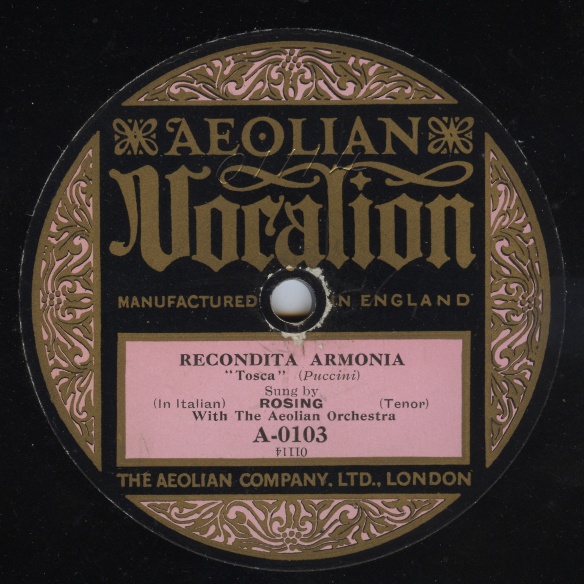
The lateral recording of the Rosing aria, in the first Aeolian Vocalion issue of January 1921
The other side of the test record might help. "Oft In The Stilly Night", played by a brass quartet doesn't seem particularly unusual, but it is a distinctive combination. All other UK recordings of the title from around this time are male vocals. Except for one, a Guardsman record of this title by the "Harmony Brass Quartet", recorded at some time in the period we are looking at. Could this be related?
A Guardsman connection?
The First World War had between 1914 and 1916 ended the UK activities of the many German-owned labels at the cheaper end of the market. The comparatively few small British record companies did well as a result. Recording expert Joe Batten had been employed by Polyphon at the start of the war, but was evidently freelancing at the time of the following anecdote.
"...a few days after [one of the earlier daylight raids on London] I was conducting for a company (whose name I have forgotten) in Chiswell Street. One of the bombs dropped in the raid had made a shambles of the next-door building; the ruins could be seen from the windows of the recording room. That morning we were to record an Italian tenor, Roselli, in the operatic arias,: "La Donna e Mobile", "E Lucevan le Stella", and "Questa o Quella". Having rehearsed, we were about to make the first title when Roselli strolled to the window and for the first time saw the devastation outside. Flinging his arms above his head, he shouted in a terrified voice some odd exclamation which sounded like "boom!" and scuttled from the room. We heard him clattering down the stairs, the bang of a door, then silence. He left behind collar and tie, music, and his fee of twelve guineas. They were never claimed."
Angelo Roselli was an Italian tenor based in Britain. There seem to be no traces of a performing career, and nor was he a prolific recording artist. Apart from some recordings for British Homochord in 1922, he seems only to have recorded for Guardsman. Guardsman also recorded the Honourable Artillery Company's band and string orchestra, and as Batten was serving in that regiment and organising troop concerts, we may confidently suppose that he was involved with these recordings.
World War 1 bombing was meticulously recorded, officially at the time, and since by expert enthusiasts. Chiswell Street is one of those streets where the numbers run in order up one side and back down the other. At the City Road end where the recording industry would have been, the north side had the lowest numbers and the south the highest.
Two bombs fell on Chiswell Street on July 7th 1917, one damaging Nos 3 and 4 on the north side, and the second Nos 88 and 89 opposite on the south. As it happens, Andres Brothers, agents for Homophon, were or had been at No 85. But this side of the road is unlikely to be the location of Roselli's 1917 recordings. From the photo of the damage to the front of No. 88, it's hard to imagine the most inattentive of tenors not noticing it on his way into the building next door.
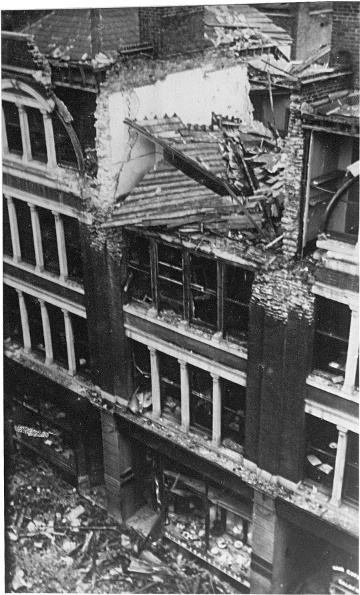
88 Chiswell Street, July 8th 1917.
I think it more likely that the bomb was the one on the north side, where the damage was apparently all at the rear. Nos 4 to 7 housed the packing firm of E.W Whiteaway, whose great-grandson has an album of photos of the damage. No. 3 was the Pied Horse pub and the location of the recording studios would then be Nos 1 - 2, known as Finsbury Square Buildings and host to a number of businesses, mainly small manufacturers.
Incidentally, and conveniently for Batten, this building backed onto the Honourable Artillery Company's ground.
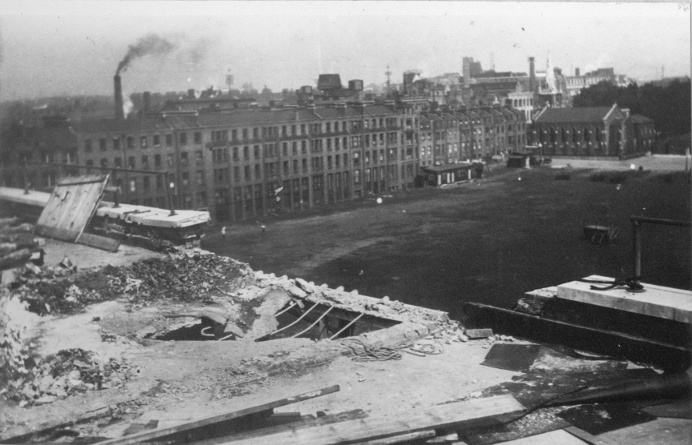
The Honourable Artillery Company's ground, from a damaged roof at Nos 4-7 Chiswell St.
Around this time Orchestrelle had a commercial relationship with the Invicta Record Co., makers of Guardsman records, giving them a foothold in the record business. No doubt they felt that as gramophone retailers they ought to have a range of "own-label" records, and in 1916 they registered the trade names Phoneto and Musola for gramophones and records and examples of both record labels seem to exist [Frank Andrews, HD 116]. These were produced by Invicta from Guardsman originals and pressed by Crystalate. Invicta's Citizen records were at the same time being exported and sold by Orchestrelle in the USA. These were surely not quite what the grand UK Orchestrelle Company had in mind for its entry into the record market, and possibly they got cold feet about Phoneto and Musola records sharing their name with Orchestrelle gramophones. This may explain their fabulous rarity and their appearance mainly in Australia.
A Meloto from a Guardsman master on Norman Field's website has the initials PJP under the wax, clearly indicating the involvement of Percy J Packman. This recording, published Roselli Guardsmans and the Guardsman brass quartet record have matrix numbers around the 1200s, which, judging from song titles, date from 1917.
We can make a good guess that Guardsman made their recordings in one of these Chiswell St buildings. And Orchestrelle? My guess is that they were in the same building, quite probably at the same premises. And that the same Brass Quartet recorded for both systems, at the same time or thereabouts. Sticking to what we know with reasonable certainty, the Orchestrelle Company or its successor Aeolian made several hundred recordings, of which almost no trace, physical or documentary, remains.
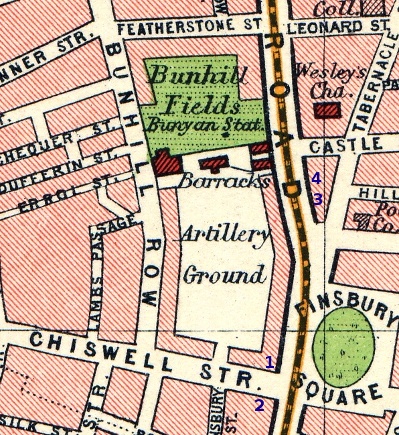
| Numbers in blue show approximate locations of
1. 1-2 Chiswell Street
2. 88 Chiswell Street
3. 15 City Road, National Gramophone Co, makers of Marathon records
4. 25 City Road, His Master's Voice London office |
Bartholomew's Handy Reference Atlas of London and Suburbs, 1917
A last personal digression. I work in that area north of the City that was the centre of the British recording industry in the years up to the First World War, and the location of events recorded here. Daily, in the most literal sense, I tread in the footsteps of Joe Batten and Percy Packman and the artists they recorded. Some of this article was written in lunchtimes at a cafe on the site of Marathon's activities, and on other days I often get something from the Tesco on the site of the Gramophone Company's head office and of Vladimir Rosing's first London recordings. This part of London has changed more than most, and the buildings have since been rebuilt at least once. Perhaps the "dot com" firms now in the area capture something of the excitement of a comparatively new technology, but it's hard now to imagine the noises of small-scale manufacture and the sounds of popular music that must have been heard here a hundred years ago.
References and Acknowledgements
Thanks for information are due to: the late Frank Andrews, as referenced in the text and from personal discussions. TMR is Talking Machine Review, HD is Hillandale News. Ryan Barna, Ian Castle, Norman Field, Ross Laird, Michael Lloyd-Davies, Richard Rosing, Tim Whiteaway (by personal correspondence).
The Rosing side can be heard on the Russian Records site.
Ryan Barna, Aeolian: Vocalion Hill and Dale Records (1918-1920)
Ian Castle, London 1917-18: The Bomber Blitz, Osprey Publishing, 2010
Norman Fields' site 78 rpm records in the U.K. 1898-1926
Joe Batten, Joe Batten's Book, Rockliff, London 1956. Now available again as as a Kindle e-book
Details of "Johnny" Johnstones's life and career Recording Pioneers
Comments, additions and corrections are welcomed at rosing notjustcamden.uk
A version of this article first appeared in For The Record no. 45, the City of London Phonograph and Gramophone Society's magazine, and is reissued here by agreement.
notjustcamden.uk
A version of this article first appeared in For The Record no. 45, the City of London Phonograph and Gramophone Society's magazine, and is reissued here by agreement.









 notjustcamden.uk
A version of this article first appeared in For The Record no. 45, the City of London Phonograph and Gramophone Society's magazine, and is reissued here by agreement.
notjustcamden.uk
A version of this article first appeared in For The Record no. 45, the City of London Phonograph and Gramophone Society's magazine, and is reissued here by agreement.